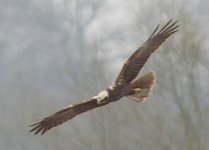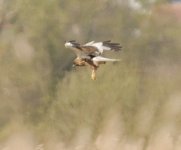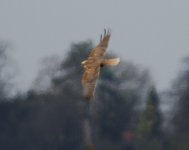Hi All,
as Pete says, it's the second such D200 body I've had that has consistently produced results like this in a variety of entirely normal shooting conditions.
The first one was worse than this!
I know what you mean Nigel, about the picture looking like there's atmospheric disturbance, but that's the camera at work: I took over a hundred MH shots while I was down there, including some where the bird was within 20 yards or so (and as I suggest above, it wasn't warm at Strumpshaw Fen when I was there) and
all of the pictures are very, very bad indeed, and all in much the same way.
Not a single one worth keeping.
Can you imagine how
gutted I was when I finally got these home and onto my PC? I'd specifically gone down to Norfolk when I did (in mid April) to get some decent shots of displaying marsh harriers and got this instead...
(I've posted up a few more below, just for comedy value! Again, 100% crops with no processing except NEF - jpeg conversion and cropping in Nikon Capture).
Then have a look at this:
http://www.birdforum.net/pp_gallery/showphoto.php/photo/94268
That's the kind of IQ I was expecting.
Another BF member - "Puddleduck" (Andy to his friends) - is on his
third D200 body, and he has had the same problems. In fact he has pretty much retired his D200 in favour of his D50 in anything other than great light, simply because in his experience the D50 kicks the D200's butt over ISO 400 (I've seen examples taken by Andy: he's right).
A search for "D200" in the BF gallery will kick up a lot of apparently OOF, noisy-as-hell, smeared, no-detail images too (which isn't a criticism of the photographers of course).
Then there's this guy,
http://www.grandwebsite.com/weddings.htm, a very capable professional wedding photographer, who was so appalled by his D200 in low light (he's a wedding photographer - I guess it matters!) that he has incurred a
huge amount of wrath from the Nikon fanboys by documenting his experiences.
Experiences that match mine perfectly - but he clearly knows how to take a photo, so "user error" doesn't really explain his problems - again, he has no such issues with his other Nikons.
Anyway - to get back on topic

- if I could choose when I went out with my camera, I'd only ever go out in nice light.
Like most amateurs/enthusiasts though, I have to take whatever chance I get, and that means taking pot-luck with the weather.
While my personal preference is not to bother when I "know" it will be a waste of time, I would be far more inclined to take the chance if I had a camera which I felt would redress the balance a bit (a cheaper option than f/2.8 lenses!) and Canon bodies in my price range are pretty well known for their comparatively good low light performance.
And equally, there is no doubt at all in my mind that my D200 makes the chance of a decent picture in less than ideal light,
far less likely.







